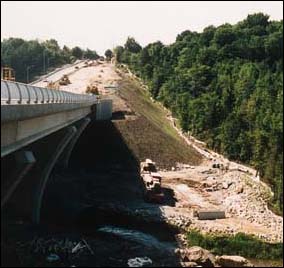Protecting Salmon During Mountainview Road Reconstruction |
 Building a bridge over a sensitive stream is always delicate business. "We're building a bridge through a very deep valley," said Doug Inouye of the Municipality of Halton. "It was important to stabilize the slopes and restore them to as natural a state as possible." That's why McCormick Rankin & Associates specified Presto's large cell, tendoned Geoweb® Cellular Confinement System for a bridge approach embankment in the Municipality of Halton, Ontario. The large cell system will provide vegetated protection on the 1.5h to 1v slope and is the first large-scale application to utilize the tendoned, large cell material for highway slope stabilization in Canada. Mountainview Road is a major arterial, linking a newly developed residential area to Highway 401 and Highway 7. The project encompasses an area from 300 meters south of #10 Side Road to 100 meters north of Summit Lane/Eden Place in the Town of Halton Hills (Georgetown). Complicating the project is the fact that the valley boasts a cold water stream, Silver Creek, which holds trout and is the spawning ground for salmon from Lake Ontario. "The stream means we've got the Federal Fisheries Act, the Ministry of the Environment and Engineering and the Credit Valley Conservation Authority involved," Inouye said. Although this project did not involve special permitting or regulations, the design had to meet the stringent criteria of all agencies. They all had to be in agreement before reaching final approval and acceptance of a design. The main objective was to minimize the human impact on the valley floor and to avoid jeopardizing the existing streambank. This project involves very steep slopes: more gradual slopes would have encroached on the forest and into the stream area. "We've had a good relationship with the Credit Valley Conservation Authority," Lyle Malcolm of McCormick Rankin & Associates said. "We're mindful of the fact that Silver Creek is a tributary of the Credit River, which has a significant salmon run from Lake Ontario. All siltation control works have been quite satisfactory to the Conservation Authority to date. We're building at a slope of 1.5h to 1v, a practice against my better judgment. That's the reason for using this material (with tendons); we're trying to minimize the footprint on the valley. It's one of the most memorable projects I can recall -- not because of the size of the bridge, but because of the sophistication of the approach fills." Tendons utilized in this project have been key in anchoring sections on steep slopes or embankments, or when a geomembrane underlay hard soil/rock prevents anchoring with stakes. McCormick Rankin wanted a permanent solution and chose this system as the primary reinforcement. They did not want to rely on typical bioengineering to hold the slope. Further, because of the timing of this project, bioengineering efforts typically done in the Spring and Fall were not possible. Instead, mass plantings of trees and shrubs will be used for additional stabilization. On the east side slopes, 850 dogwood trees will be planted within the cells. Upon completion of the west side slopes, similar plantings are planned. Mardave Construction Ltd. is the contractor for the project. The east side of the construction site was successfully completed in late fall of 1996. The system's reinforcement structure supported hydroseeding, done by Dole Brothers, as a means to establish vegetation. As a result, the side slopes are now covered with a dense growth of vegetation. Despite persistent rains, the newly vegetated east side slopes have shown no signs of erosion. Progress continues on the west side as the project nears completion. Reports indicate "thumbs up" for performance on this project! L&W For more information, contact Pat Stelter, Presto Products Company, P.O. Box 2399, Appleton, WI 54913-2399, (800)558-3525, fax (414)738-1418. |
©2000, 1999, 1998 Land and Water, Inc.